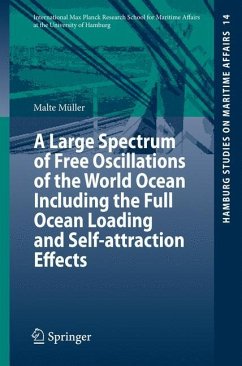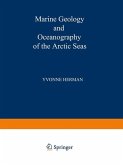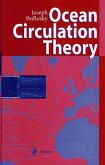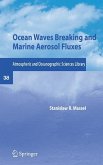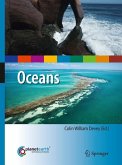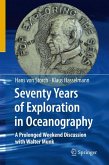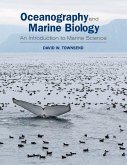The ocean tides are the most prominent forced oscillations in the global ocean. Recent research showed that tides play an important role for the earth's climate system and they are of considerable interest for the post-processing of satellite data. To understand these oscillations it is substantial to determine and analyse the free oscillations, which describe the oscillation behaviour of the global ocean. A highly efficient ocean model is developed to compute these free oscillations with explicit consideration of dissipative terms and the full ocean loading and self-attraction (LSA). The obtained spectrum of free oscillations enables e.g. an detailed analyses of the LSA effect on tides, the synthesis of tides by free oscillations and to show the existence of six long period planetary vorticity modes.
ThisbookdependsonadissertationpreparedattheDepartementofGeosciencesat theUniversityHamburg. ItwasacceptedbytheDepartementwiththegradesumma cumlaudein2008. IwouldliketothankmyacademicadvisorProf. Dr. WilfriedZahelforhisconstant supportandforthelongandconstructivediscussions. Further,IwouldliketothankProf. Dr. Jur genSundermann forintroducingmeto theInternationalMaxPlanckResearchSchool. TheInternationalMaxPlanckResearchSchoolforMaritimeAffairsandinparticu larProf. Dr. Dr. h. c. Jur genBasedowandhisco directorsarethankedforgivingme theopportunitytoperformthisstudyinHamburg. IacknowledgethecomputationalsupportoftheDKRZandNEC,especiallythe helpfulcommentsofKlausKetelsenandJens OlafBeismann. LastbutnotleastmanythankstomywifeJanaSillmannandmysonDariusfor givingmethetimeIneededforthisstudyandprovidingajoyfulandlovinghome. ThisworkhasbeenfundedbytheInternationalMaxPlanckResearchSchoolfor MaritimeAffairsattheUniversityHamburg. Hamburg,August2008 MalteMuller Contents Abstract. . . . . . . .. . . . . . . . . . . . . . . . . . . . . . . . . . . . . . . . . . . . . . . . . . . . . . . . . . . 1 1 Introduction. . . . . . . . . . . . . . . . . . . . . . . . . . . . . . . . . . . . . . . . . . . . . . . . . . . 3 2 TheoryandModel . . . . . . . . . . . . . . . . . . . . . . . . . . . . . . . . . . . . . . . . . . . . . 7 2. 1 Theory . . . . . . . . . . . . . . . . . . . . . . . . . . . . . . . . . . . . . . . . . . . . . . . . . . . 7 2. 1. 1 SecondaryForces:TheLoadingandSelf AttractionEffect . 8 2. 1. 2 TheEquationsofMotionandtheEquationofContinuity. . . 11 2. 1. 3 EnergyBalance. . . . . . . . . . . . . . . . . . . . . . . . . . . . . . . . . . . . . . 14 2. 1. 4 ParameterizationoftheLSA AnAnalyticalApproach . . . . 16 2. 2 Model. . . . . . . . . . . . . . . . . . . . . . . . . . . . . . . . . . . . . . . . . . . . . . . . . . . . 18 2. 2. 1 TheImplicitlyRestartedArnoldiMethod. . . . . . . . . . . . . . . . 19 2. 2. 2 TheParallelizationwithMPI . . . . . . . . . . . . . .. . . . . . . . . . . . 21 2. 2. 3 ThePerformanceoftheModel. . . . . . . . . . . . . . . . . . . . . . . . . 21 3 TheFreeOscillations. . . . . . . . . . . . . . . . . . . . . . . . . . . . . . . . . . . . . . . . . . . 23 3. 1 GravitationalModes. . . . . . . . . . . . . . . . . . . . . . . . . . . . . . . . . . . . . . . . 23 3. 1. 1 The? value. . . . . . . . . . . . . . . . . . . . . . . . . . . . . . . . . . . . . . . . . 24 3. 1. 2 TheIn?uenceoftheLSA . . . . . . . . . . . . . . . . . . . . . . . . . . . . . 25 3. 1. 3 TheAntarcticKelvinWave. . . . . . . . . . . . . . . . . . . . . . . . . . . . 30 3. 1. 4 NewModes. . . . . . . . . . . . . . . . . . . . . . . . . . . . . . . . . . . . . . . . . 30 3. 1. 5 TheSlowestModes . . . . . . . . . . . . . . . . . . . . . . . . . . . . . . . . . . 31 3. 2 VorticityModes. . . . . . . . . . . . . . . . . . . . . . . . . . . . . . . . . . . . . . . . . . . . 32 3. 2. 1 TopographicalVorticityModes. . . . . . . . . . . . . . . . . . . . . . . . . 32 3. 2. 2 PlanetaryVorticityModes. . . . . . . . . . . . . . . . . . . . . . . . . . . . . 34 4 SynthesisofForcedOscillations. . . . . . . . . . . . . . . . . . . . . . . . . . . . . . . . . . 39 4. 1 TidalDynamicsandtheIn?uenceofLSA. . . . . . . . . . . . . . . . . . . . . . 40 4. 1. 1 TheProcedureofTidalSynthesis. . . . . . . . . . . . . . . . . . . . . . . 40 4. 1. 2 LSA effectonForcedOscillations. . . . . . . . . . . . . . . . . . . . . . 45 4. 1. 3 TheSynthesisoftheSemidiurnalandDiurnalTides. . . . . . . 50 xi xii Contents 4. 2 IntegrationoftheSolutionsofaTidalModelwithAssimilationof Data. . . . . . . . . . . . . . . . . . . . . . . . . . . . . . . . . . . . . . . . . . . . . . . . . . . . . . 55 4. 2. 1 NewExpansionCoef?cients. . . . . . . . . . . . . . . . . . . . . . . . . . . 55 4. 2. 2 NewFrequenciesandAdjointEigenfunctions . . . . . . . . . . . . 59 4. 2. 3 Results. . . . . . . . . . . . . . . . . . . . . . . . . . . . . . . . . . . . . . . . . . . . . 61 4. 2. 4Summary. . . . .
ThisbookdependsonadissertationpreparedattheDepartementofGeosciencesat theUniversityHamburg. ItwasacceptedbytheDepartementwiththegradesumma cumlaudein2008. IwouldliketothankmyacademicadvisorProf. Dr. WilfriedZahelforhisconstant supportandforthelongandconstructivediscussions. Further,IwouldliketothankProf. Dr. Jur genSundermann forintroducingmeto theInternationalMaxPlanckResearchSchool. TheInternationalMaxPlanckResearchSchoolforMaritimeAffairsandinparticu larProf. Dr. Dr. h. c. Jur genBasedowandhisco directorsarethankedforgivingme theopportunitytoperformthisstudyinHamburg. IacknowledgethecomputationalsupportoftheDKRZandNEC,especiallythe helpfulcommentsofKlausKetelsenandJens OlafBeismann. LastbutnotleastmanythankstomywifeJanaSillmannandmysonDariusfor givingmethetimeIneededforthisstudyandprovidingajoyfulandlovinghome. ThisworkhasbeenfundedbytheInternationalMaxPlanckResearchSchoolfor MaritimeAffairsattheUniversityHamburg. Hamburg,August2008 MalteMuller Contents Abstract. . . . . . . .. . . . . . . . . . . . . . . . . . . . . . . . . . . . . . . . . . . . . . . . . . . . . . . . . . . 1 1 Introduction. . . . . . . . . . . . . . . . . . . . . . . . . . . . . . . . . . . . . . . . . . . . . . . . . . . 3 2 TheoryandModel . . . . . . . . . . . . . . . . . . . . . . . . . . . . . . . . . . . . . . . . . . . . . 7 2. 1 Theory . . . . . . . . . . . . . . . . . . . . . . . . . . . . . . . . . . . . . . . . . . . . . . . . . . . 7 2. 1. 1 SecondaryForces:TheLoadingandSelf AttractionEffect . 8 2. 1. 2 TheEquationsofMotionandtheEquationofContinuity. . . 11 2. 1. 3 EnergyBalance. . . . . . . . . . . . . . . . . . . . . . . . . . . . . . . . . . . . . . 14 2. 1. 4 ParameterizationoftheLSA AnAnalyticalApproach . . . . 16 2. 2 Model. . . . . . . . . . . . . . . . . . . . . . . . . . . . . . . . . . . . . . . . . . . . . . . . . . . . 18 2. 2. 1 TheImplicitlyRestartedArnoldiMethod. . . . . . . . . . . . . . . . 19 2. 2. 2 TheParallelizationwithMPI . . . . . . . . . . . . . .. . . . . . . . . . . . 21 2. 2. 3 ThePerformanceoftheModel. . . . . . . . . . . . . . . . . . . . . . . . . 21 3 TheFreeOscillations. . . . . . . . . . . . . . . . . . . . . . . . . . . . . . . . . . . . . . . . . . . 23 3. 1 GravitationalModes. . . . . . . . . . . . . . . . . . . . . . . . . . . . . . . . . . . . . . . . 23 3. 1. 1 The? value. . . . . . . . . . . . . . . . . . . . . . . . . . . . . . . . . . . . . . . . . 24 3. 1. 2 TheIn?uenceoftheLSA . . . . . . . . . . . . . . . . . . . . . . . . . . . . . 25 3. 1. 3 TheAntarcticKelvinWave. . . . . . . . . . . . . . . . . . . . . . . . . . . . 30 3. 1. 4 NewModes. . . . . . . . . . . . . . . . . . . . . . . . . . . . . . . . . . . . . . . . . 30 3. 1. 5 TheSlowestModes . . . . . . . . . . . . . . . . . . . . . . . . . . . . . . . . . . 31 3. 2 VorticityModes. . . . . . . . . . . . . . . . . . . . . . . . . . . . . . . . . . . . . . . . . . . . 32 3. 2. 1 TopographicalVorticityModes. . . . . . . . . . . . . . . . . . . . . . . . . 32 3. 2. 2 PlanetaryVorticityModes. . . . . . . . . . . . . . . . . . . . . . . . . . . . . 34 4 SynthesisofForcedOscillations. . . . . . . . . . . . . . . . . . . . . . . . . . . . . . . . . . 39 4. 1 TidalDynamicsandtheIn?uenceofLSA. . . . . . . . . . . . . . . . . . . . . . 40 4. 1. 1 TheProcedureofTidalSynthesis. . . . . . . . . . . . . . . . . . . . . . . 40 4. 1. 2 LSA effectonForcedOscillations. . . . . . . . . . . . . . . . . . . . . . 45 4. 1. 3 TheSynthesisoftheSemidiurnalandDiurnalTides. . . . . . . 50 xi xii Contents 4. 2 IntegrationoftheSolutionsofaTidalModelwithAssimilationof Data. . . . . . . . . . . . . . . . . . . . . . . . . . . . . . . . . . . . . . . . . . . . . . . . . . . . . . 55 4. 2. 1 NewExpansionCoef?cients. . . . . . . . . . . . . . . . . . . . . . . . . . . 55 4. 2. 2 NewFrequenciesandAdjointEigenfunctions . . . . . . . . . . . . 59 4. 2. 3 Results. . . . . . . . . . . . . . . . . . . . . . . . . . . . . . . . . . . . . . . . . . . . . 61 4. 2. 4Summary. . . . .

